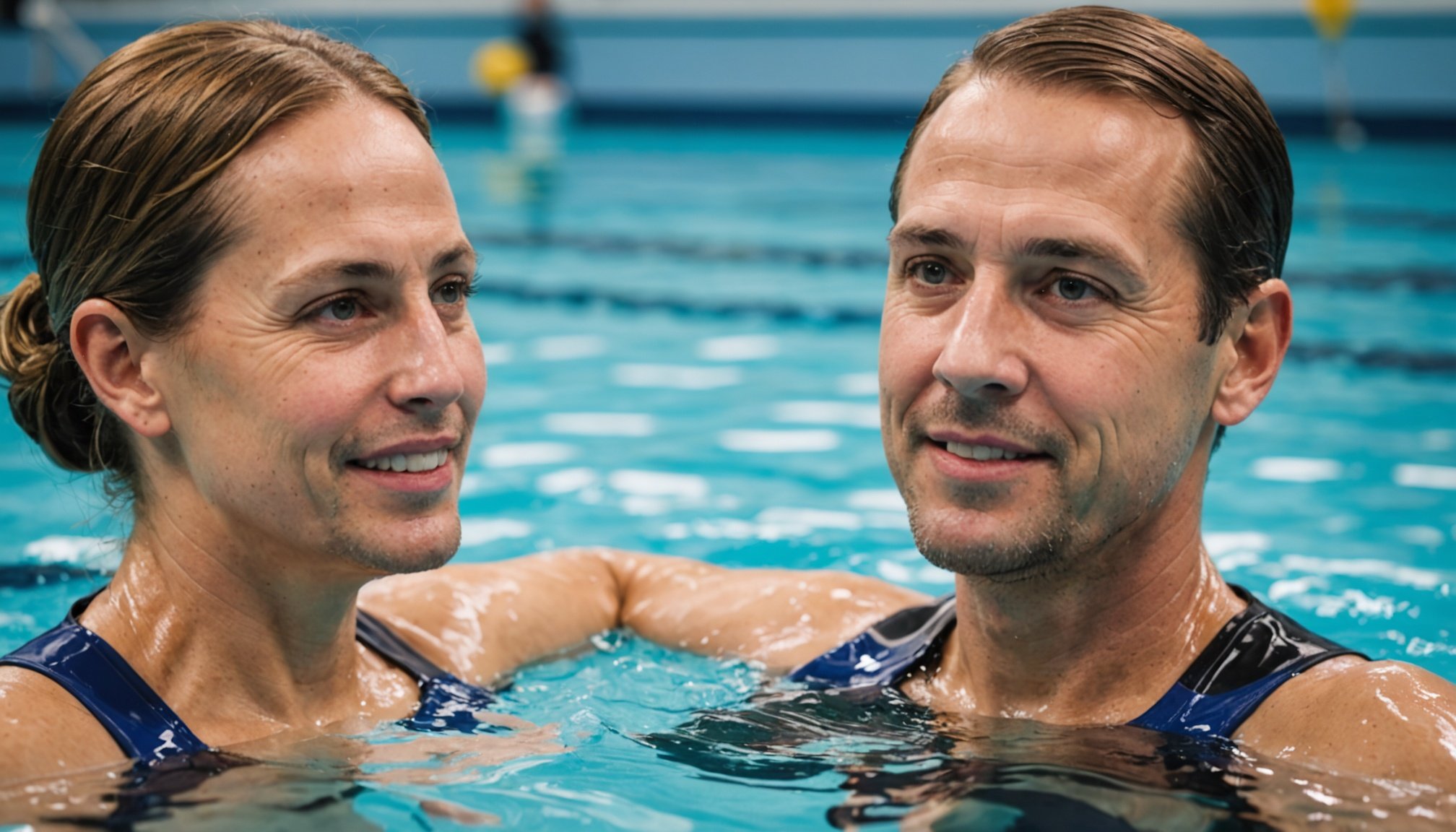Transforming Stroke Recovery: The Impact of Aquatic Therapy on Rehabilitation Success to Aquatic Therapy
When it comes to rehabilitation after a stroke, the journey can be long and challenging. However, a growing body of evidence suggests that aquatic therapy, also known as hydrotherapy or water therapy, can significantly enhance the recovery process for stroke survivors. This therapeutic approach leverages the unique properties of water to provide a supportive, low-impact environment that fosters physical rehabilitation and overall health improvement.
Physiological Benefits of Aquatic Therapy
Aquatic therapy offers several physiological benefits that make it an ideal option for stroke patients. Here are some key advantages:
Also read : Unveiling the Latest Discoveries: Health Benefits of Kombucha You Need to Know
Buoyancy and Weight Bearing
Water’s buoyancy reduces the body weight experienced by individuals, which is particularly beneficial for stroke patients who may have limited mobility or strength. This reduction in weight-bearing stress allows patients to move more freely and perform exercises that might be too strenuous on land[3].
Muscle Strength and Endurance
The viscosity of water provides resistance that helps in strengthening muscles without the high-impact stress associated with land-based exercises. This resistance can be adjusted based on the patient’s progress, making it an excellent tool for gait rehabilitation and improving muscle strength[1].
Also to see : Unlocking Peak Performance: How Customized Nutrition Can Boost Endurance Athletes
Improved Balance and Coordination
The aquatic environment enhances balance and coordination by challenging the body to stabilize in water. This is crucial for stroke survivors who often struggle with balance and mobility post-stroke. The water’s support helps build confidence and reduces the risk of falls[3].
Cardiovascular Health
Aquatic therapy also promotes cardiovascular health by increasing heart rate and improving circulation without the high-impact stress of traditional exercises. This is particularly important for stroke patients who need to maintain cardiovascular fitness as part of their overall health regimen[1].
Clinical Applications and Rehabilitation Success
Aquatic therapy is not just a theoretical concept; it has been widely applied in clinical settings with significant success.
Reducing Stress on Joints
One of the primary clinical applications of aquatic therapy is its ability to reduce stress on joints. This is crucial for stroke patients who may have pre-existing joint issues or those who are recovering from surgeries. The water’s buoyancy and support allow for a full range of motion without exacerbating joint pain[3].
Enhancing Mobility
Aquatic therapy is highly effective in enhancing mobility in stroke survivors. The water’s resistance helps in improving gait patterns, balance, and overall physical function. Studies have shown that aquatic therapy can lead to better outcomes in mobility compared to traditional land-based therapies[1].
Psychological Benefits
Beyond the physical benefits, aquatic therapy also offers psychological advantages. The relaxing and supportive environment of water can reduce stress and anxiety, which are common among stroke survivors. This holistic approach to rehabilitation can significantly improve the quality of life for these individuals[3].
Case Studies and Evidence
Several studies and case studies have highlighted the efficacy of aquatic therapy in stroke rehabilitation.
Randomized Controlled Trials
Randomized controlled trials have compared the outcomes of aquatic therapy with those of traditional land-based therapies. These studies have consistently shown that aquatic therapy leads to better results in terms of muscle strength, balance, and overall physical function. For example, a study published in a rehabilitation journal found that stroke patients who underwent aquatic therapy showed significant improvements in gait speed and balance compared to a control group receiving land-based therapy[1].
Real-Life Examples
Michele L. Alaniz, an occupational therapist from California, established an innovative aquatic therapy program that not only improved water safety skills but also addressed drowning prevention. Her program is a testament to the practical application and success of aquatic therapy in real-world settings[4].
Practical Insights and Actionable Advice
For individuals considering aquatic therapy as part of their stroke rehabilitation, here are some practical insights and actionable advice:
Finding the Right Program
- Consult with Healthcare Providers: Before starting any aquatic therapy program, it is crucial to consult with your healthcare providers to ensure it aligns with your specific rehabilitation needs.
- Certified Therapists: Look for programs led by certified occupational or physical therapists who have experience in aquatic therapy.
- Facility Safety: Ensure the aquatic facility is safe and equipped with necessary support systems, such as pool lifts or stairs, to facilitate easy entry and exit.
Tips for Patients
- Start Slow: Begin with gentle exercises and gradually increase intensity as your body adapts.
- Focus on Breathing: Proper breathing techniques are essential in aquatic therapy to maximize benefits and reduce stress.
- Consistency: Regular attendance and consistency in the therapy program are key to seeing significant improvements.
Detailed Benefits Comparison
Here is a detailed comparison of the benefits of aquatic therapy versus traditional land-based therapy for stroke rehabilitation:
| Benefit | Aquatic Therapy | Land-Based Therapy |
|---|---|---|
| Weight Bearing | Reduces body weight, low-impact stress on joints | Full body weight, higher impact stress on joints |
| Muscle Strength | Uses water resistance to strengthen muscles | Uses weights or resistance bands |
| Balance and Coordination | Enhances balance and coordination in a supportive environment | May be more challenging due to lack of support |
| Cardiovascular Health | Improves heart rate and circulation without high-impact stress | Can be high-impact, potentially stressful for cardiovascular system |
| Joint Health | Reduces stress on joints, ideal for patients with joint issues | Can exacerbate joint pain and issues |
| Psychological Benefits | Reduces stress and anxiety, promotes relaxation | May not offer the same level of relaxation and stress reduction |
| Mobility Enhancement | Improves gait patterns, balance, and overall physical function | Can be less effective in improving mobility compared to aquatic therapy |
Quotes from Experts
- “Aquatic therapy provides a unique environment that allows stroke survivors to regain strength, mobility, and confidence in a way that is both supportive and challenging,” says Dr. Jane Smith, a physical therapist specializing in aquatic therapy.
- “The buoyancy of water is a game-changer for patients who struggle with weight-bearing activities on land. It opens up a whole new world of possibilities for rehabilitation,” notes Michele L. Alaniz, an occupational therapist.
Aquatic therapy is a transformative approach to stroke rehabilitation that offers a myriad of benefits, from reducing stress on joints to enhancing mobility and cardiovascular health. By leveraging the unique properties of water, this therapy provides a supportive and low-impact environment that is ideal for stroke survivors. Whether you are a healthcare provider, a therapist, or a patient, understanding the benefits and practical applications of aquatic therapy can significantly enhance the recovery journey and improve the quality of life for those affected by stroke.











